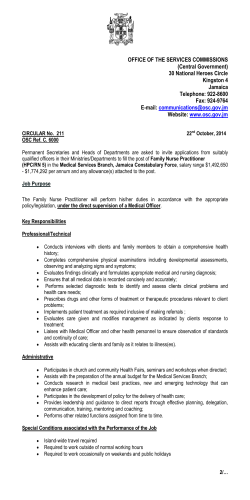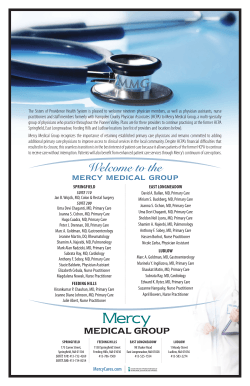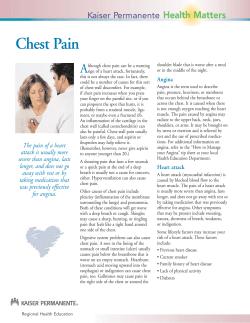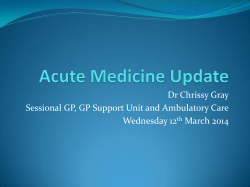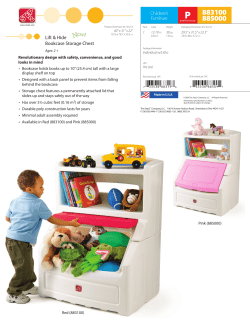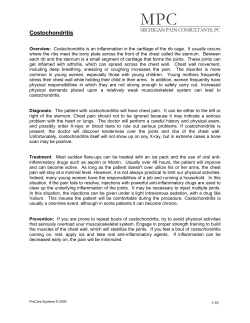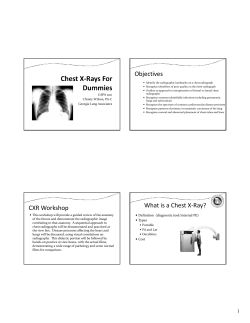
Nurse Practitioner CLINICAL PROTOCOL Chest Pain
Nurse Practitioner CLINICAL PROTOCOL Chest Pain INTRODUCTION: Patients presenting with chest pain require rapid evaluation. Myocardial ischaemia should be considered in all patients presenting with chest pain. Assessment of pain type and referral, and response of pain to various interventions is important in differentiating between cardiac and non-cardiac chest pain. If the pain is cardiac in nature it is important to respond quickly to ensure the best possible outcome for the Pt. DIFFERENTIAL DAIGNOSIS: • CVS CAUSES; AMI, unstable angina, aortic dissection, aortic aneurysm, pericarditis, aortic stenosis, mitral valve prolapse. • RESP CAUSES; pulmonary embolism, pneumothorax, severe pneumonia. • GI CAUSES; oesophageal spasm or rupture, gastric reflux, indigestion, perforated peptic ulcer. • Musculoskeletal causes. • Trauma or neoplasm. • Psychiatric causes. CLINICAL PRACTICE GUIDELINE Nurse Practitioner • Scope Chest pain responsive to protocols outlined within this CP. Medical • Chest pain unresponsive to treatment Practitioner outlined within this CP. +/• Evidence/suspicion of AMI or more Nurse serious cause of pain. Practitioner Initial Assessment and Interventions Presenting • Relevant past medical Hx and History medication history • Known allergies • Pt. describes pain as squeezing, pressing, constricting, and heavy in central chest, +/- radiating to left arm, neck or jaw. • Pt. may feel a “sense of impending doom”. Outcomes Identify patients suitable for NP clinical protocol. Refer unsuitable pts. to current GP. Identify patients not suitable for NP CP and redirect to usual GP care +/- ED Outcomes Identify patients not suitable for NP CP and redirect to usual GP care +/- ED Nurse Practitioner CLINICAL PROTOCOL Chest Pain Physical examination • • Primary survey – ABC Vital signs (T, P, R, BP), ECG if available. Signs of ST elevation – refer GP/ED for thrombolysis. • Assess pain: time of onset, position of pain including any radiation, description of pain, severity of pain, length of time pain has been present, frequency of pain episodes, what were you doing when the pain started, does anything make it better or worse, is it reproducible by palpation • Any nausea, epigastric discomfort? • Note any diaphoresis. • Any SOB or dizziness • Is the Pt. pale? Be aware of atypical signs/symptoms: • No chest pain, but pain related to exertion or stress in the left arm or jaw. • Epigastric discomfort. • Unexplained fatigue. • Indigestion, belching. • Dizziness • Pain in the right arm. • Confusion. • Assess associated vascular risk factors (eg strong family Hx). Identify patients not suitable for NP CP → exit CP and refer to current GP. Pain assessment Asses level of pain using appropriate pain scale. Morphine 2.5 – 5mg IV then titrate to effect if required (GP only). Determine need for and type of analgesia required. Pathology • Imaging • Investigations Troponin, FBC, U&E, CK, LFT’s CXR if respiratory cause suspected. Patient Education / Follow-up Follow up Verbal instruction to patient: appointment • Review appointment may be indicated by pathology results; NP to contact patient to schedule follow-up Outcomes Refer to GP for ongoing management. Diagnosis of cause of pain and application of correct treatment regime. Outcomes Ensure patient understands problem, treatment and follow up. Nurse Practitioner CLINICAL PROTOCOL Chest Pain appointment. Patient Education Verbal instruction and patient information handout if required and appropriate. Patient understanding of the problem, treatment and measures which may reduce the risk of ongoing complications. Medication • Verbal/written instructions from NP/GP Ensure patient understands problem, treatment and follow instructions up Referrals Referrals may be required for specific patient Patients with problems outside problems or as required to: the NPs scope of practice are • Physiotherapy referred to appropriate health • Drug and alcohol counsellor care providers. • Other problems outside of NP scope of practice Ensure appropriate Certificates • Absence from work certificates • Certificate of attendance documentation completed Letter • Copy of notes to GP / Specialist or Ensure continuity of care and acute care facility referral to health care team GP Æ hospital admission Interpretation of results and management decisions Outcome All medications will be stored, labelled and dispensed in accordance with hospital policy and relevant legislation Nurse e Practition ner CLINICA AL PROTO OCOL Ch hest Pain Inittial manag gement path hway Reassu ure Pt. Plac ce Pt. in an upright u positio on Give O2 2-4 L/nasal cannula c if available. Assess vital signs (ECG if availa able) Assess ch hest pain If no resp ponse to glyc ceryl trinitrate– – refer to cu urrent GP for further advice and d ment. managem eriences a cardiac c If Pt. expe arrest – commence c b basic life support/a advanced life e support as per fac cility protoco ol. r to Documenttation and referral current GP, transfer to t nearest cy departme ent. Emergenc er sublingual glyceryl triniitrate as Administe prescrribed Assess vittal signs Iff no response e after 5 mins s Repea at sublingual glyceryl trinittrate Assess vittal signs Iff no response e after 5 mins s Repea at sublingual glyceryl trinittrate Assess vittal signs If pain is unresolv ved after 20 mins m (3 doses of glyc ceryl trinitrate e) CAL LL 000 FOR AN A AMBULANC CE Administer 300mgs Aspirin n R Reassess Pt. every e 5 mins Administer analg gesia if requ uired y if necessa ary Maintain airway C Continue to reassure r Pt.. Nurse Practitioner CLINICAL PROTOCOL Chest Pain Goals of Treatment • Relief of symptoms • Prevention of recurrence • Prevention of complications Drug Formulary FORMULARY GLYCERYL TRINITRATE ASPIRIN Drug (generic name): Glyceryl Trinitrate Drug (generic name): Aspirin Dosage range: 400 mgs (spray) OR 600microgram (tablet) Dosage range: 150 - 300mg Route: oral (sublingual) Route: oral Frequency of administration: 5 minutely if pain persists Frequency of administration: immediately Duration of order: as required max of 3 metered doses, or 3 Duration of order: single dose tablets (1800 micrograms). Actions: immediate antiplatelet effect, produces complete Actions: Venodialting effects, reduction in venous return and inhibition of thromboxane-mediated platelet aggregation preload to the heart therefore reducing myocardial oxygen within 30 minutes. requirement. Indications for use: Acute chest pain with suspicion of acute Indications for use: Prevention and treatment of angina, coronary syndrome. acute heart failure associated with MI. Contraindications for use: Known NSAID hypersensitivity Contraindications for use: hypovolaemia, raised ICP, G6PD (esp. asthma). deficiency (risk of haemolytic anaemia). Adverse drug reactions: bleeding, GI upset, Adverse drug reactions: headache, flushing, palpitations, fainting, peripheral oedema. Rarely – rebound angina. Unexpected representation NP Clinical Practice Evaluative strategies Review Patient Notes. Full audit of clinical events. NP Clinical Practice/Medical Report Audit Nurse Practitioner CLINICAL PROTOCOL Chest Pain Key Terms NP – Nurse Practitioner CP – Clinical Protocol GP – General Practitioner S4 – Schedule of the drug administration act References 1. Australian Medicines handbook (internet). 2011, Nov. Accessed 2011 Dec 1 at http://www.amh.net.au 2. etg complete (internet). Melbourne: Therapeutic Guidelines Limited; 2011 Nov. Accessed 2011 Dec 1 at http://etg.tg.com.au/ref/ref Authorship, Endorsement and acknowledgement This CP was originally written by: Reviewed and authorised by: Carol Jones Dr. Frank Reedman Jones Nurse Practitioner MBBCh, DCH, DRCOG, FRACGP, FACRRM Murray Medical Centre Mandurah Murray Medical Centre: Primary Care Physician We acknowledge the authorship and input of : Dr. Eileen Bristol MBChB,MRCGP,DRCOG,FRACGP Murray Medical Centre: Primary Care Physician Carol Jones RN, RM, PGradDipNursePractitioner, NP Nurse Practitioner Date Written: November 2011 Review Date: November 2013
© Copyright 2025

